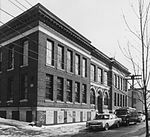Federal Hill, Providence, Rhode Island
1788 establishments in the United StatesAll pages needing cleanupEthnic enclaves in Rhode IslandFederal Hill, Providence, Rhode IslandItalian-American culture in Providence, Rhode Island ... and 3 more
Little Italys in the United StatesNeighborhoods in Providence, Rhode IslandWikipedia introduction cleanup from January 2017

Federal Hill is a neighborhood in Providence, Rhode Island. It lies immediately west of the city's Downtown, across Interstate 95. Since the late 19th century, Federal Hill has been an enclave of Providence's Italian American community; today the neighborhood is known as Providence's Little Italy and is noted for its abundance of Italian restaurants, markets, and cultural establishments.
Excerpt from the Wikipedia article Federal Hill, Providence, Rhode Island (License: CC BY-SA 3.0, Authors, Images).Federal Hill, Providence, Rhode Island
Broadway, Providence
Geographical coordinates (GPS) Address Nearby Places Show on map
Geographical coordinates (GPS)
| Latitude | Longitude |
|---|---|
| N 41.82 ° | E -71.43 ° |
Address
Broadway
02902 Providence
Rhode Island, United States
Open on Google Maps










